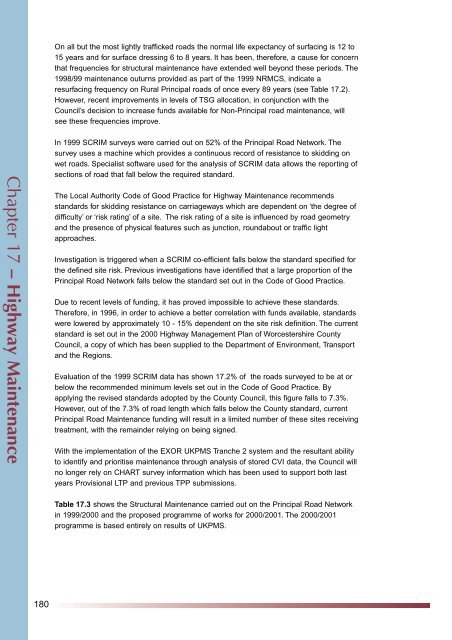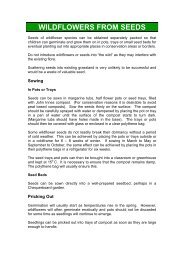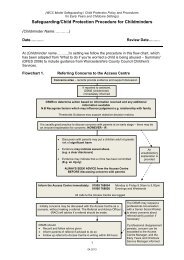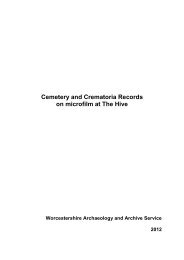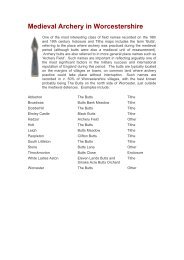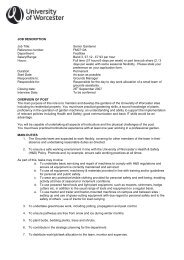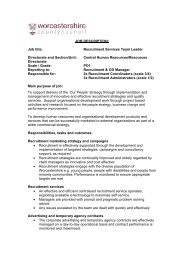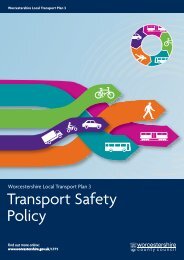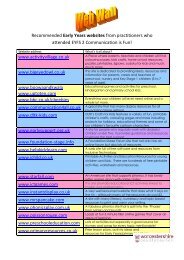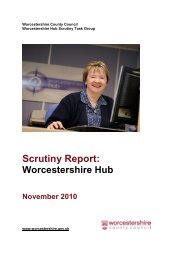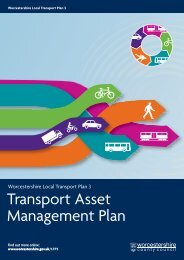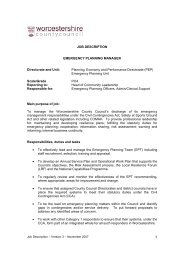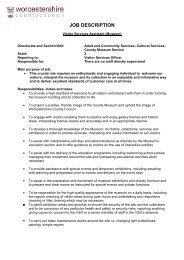Integrated Public Transport Strategy - Worcestershire County Council
Integrated Public Transport Strategy - Worcestershire County Council
Integrated Public Transport Strategy - Worcestershire County Council
Create successful ePaper yourself
Turn your PDF publications into a flip-book with our unique Google optimized e-Paper software.
Chapter 17 – Highway Maintenance<br />
180<br />
On all but the most lightly trafficked roads the normal life expectancy of surfacing is 12 to<br />
15 years and for surface dressing 6 to 8 years. It has been, therefore, a cause for concern<br />
that frequencies for structural maintenance have extended well beyond these periods. The<br />
1998/99 maintenance outurns provided as part of the 1999 NRMCS, indicate a<br />
resurfacing frequency on Rural Principal roads of once every 89 years (see Table 17.2).<br />
However, recent improvements in levels of TSG allocation, in conjunction with the<br />
<strong>Council</strong>’s decision to increase funds available for Non-Principal road maintenance, will<br />
see these frequencies improve.<br />
In 1999 SCRIM surveys were carried out on 52% of the Principal Road Network. The<br />
survey uses a machine which provides a continuous record of resistance to skidding on<br />
wet roads. Specialist software used for the analysis of SCRIM data allows the reporting of<br />
sections of road that fall below the required standard.<br />
The Local Authority Code of Good Practice for Highway Maintenance recommends<br />
standards for skidding resistance on carriageways which are dependent on ‘the degree of<br />
difficulty’ or ‘risk rating’ of a site. The risk rating of a site is influenced by road geometry<br />
and the presence of physical features such as junction, roundabout or traffic light<br />
approaches.<br />
Investigation is triggered when a SCRIM co-efficient falls below the standard specified for<br />
the defined site risk. Previous investigations have identified that a large proportion of the<br />
Principal Road Network falls below the standard set out in the Code of Good Practice.<br />
Due to recent levels of funding, it has proved impossible to achieve these standards.<br />
Therefore, in 1996, in order to achieve a better correlation with funds available, standards<br />
were lowered by approximately 10 - 15% dependent on the site risk definition. The current<br />
standard is set out in the 2000 Highway Management Plan of <strong>Worcestershire</strong> <strong>County</strong><br />
<strong>Council</strong>, a copy of which has been supplied to the Department of Environment, <strong>Transport</strong><br />
and the Regions.<br />
Evaluation of the 1999 SCRIM data has shown 17.2% of the roads surveyed to be at or<br />
below the recommended minimum levels set out in the Code of Good Practice. By<br />
applying the revised standards adopted by the <strong>County</strong> <strong>Council</strong>, this figure falls to 7.3%.<br />
However, out of the 7.3% of road length which falls below the <strong>County</strong> standard, current<br />
Principal Road Maintenance funding will result in a limited number of these sites receiving<br />
treatment, with the remainder relying on being signed.<br />
With the implementation of the EXOR UKPMS Tranche 2 system and the resultant ability<br />
to identify and prioritise maintenance through analysis of stored CVI data, the <strong>Council</strong> will<br />
no longer rely on CHART survey information which has been used to support both last<br />
years Provisional LTP and previous TPP submissions.<br />
Table 17.3 shows the Structural Maintenance carried out on the Principal Road Network<br />
in 1999/2000 and the proposed programme of works for 2000/2001. The 2000/2001<br />
programme is based entirely on results of UKPMS.


